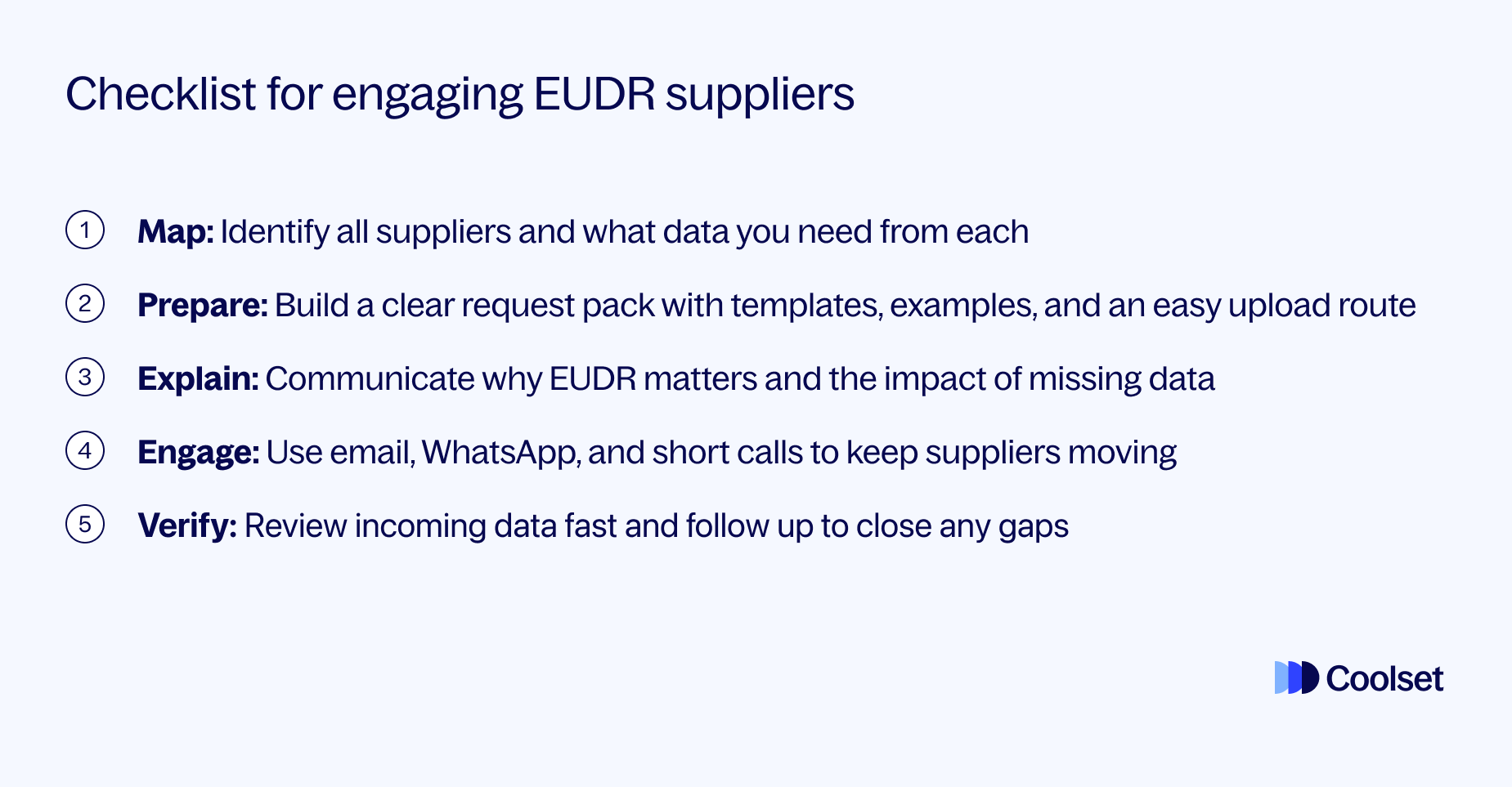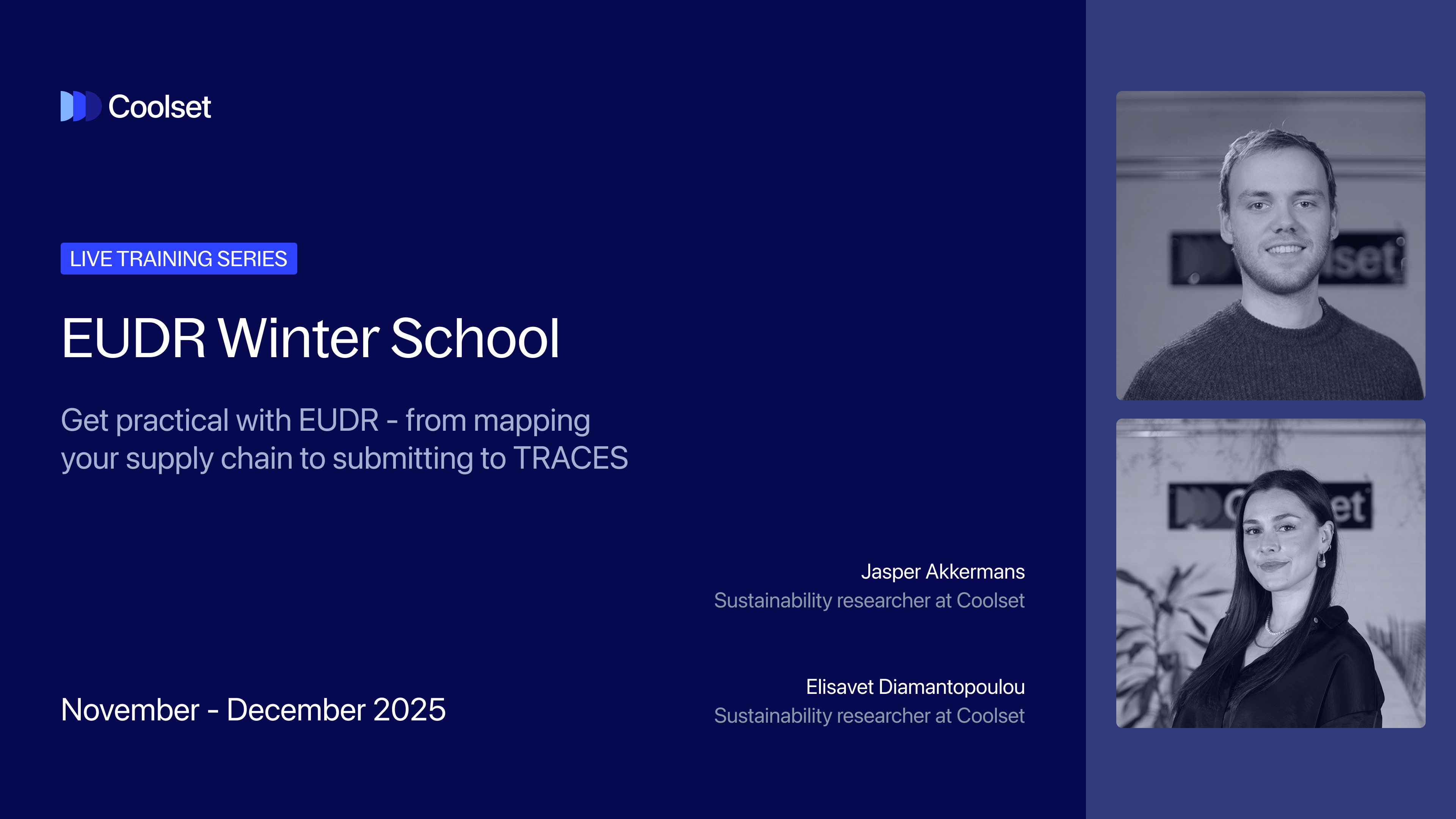Disclaimer: Latest EUDR developments
On 21 October, the European Commission proposed targeted changes to the EU Deforestation Regulation (EUDR). These adjustments aim to make the rollout smoother without changing the regulation’s overall goals.
Key points from the proposal:
We're closely monitoring the development and will update our content accordingly. In the meantime, read the full explainer here.
Most of the data required for the EU’s Deforestation Regulation (EUDR), such as geolocation, land legality, and production evidence, does not exist within a company’s internal systems. While internal teams can control their own systems and documentation, the vast majority of traceability, legality, and deforestation-related data comes from upstream suppliers and producers, who may not share your urgency, digital infrastructure, or understanding of the law.
In practice, this means that companies can face late responses, inconsistent file formats, unclear or outdated documents, and in some cases, silence. If suppliers don’t engage, no amount of internal preparation is enough to produce a compliant Due Diligence Statement (DDS). For a detailed checklist of what’s required under the regulation, refer to our EUDR Due Diligence Guide.
In our recent EUDR Winter School webinar, we explored the difficulty of engaging suppliers.
This article breaks down the discussions in this webinar, focusing on the operational realities of collecting EUDR supplier data, building cooperation, and staying compliant, even when working with low-tech, high-risk, or unresponsive partners. It reflects the real-world insights shared in the Coolset EUDR Winter School webinar series, focusing on practical steps forward to address gaps.
To comply with the EUDR you must gather shipment, supply chain, origin, and due diligence data for each relevant batch. This includes proving that products are:
To support this, the following supplier data is required:
EU-based suppliers must provide a valid DDS reference through the TRACES portal. Non-EU suppliers must submit the full documentation package to meet legal requirements.
{{custom-cta}}
The process begins long before data collection, with a structured approach recommended to ensure suppliers understand what’s needed and how to deliver it.
The first EUDR Winter School webinar outlines how to go about mapping your supply chain. This could involve listing all suppliers with EUDR-relevant products.
Segment by:
This informs where to focus effort and what support or escalation mechanisms you might need.
Build a supplier-facing pack that includes:
Whether sustainability, compliance, or procurement, assign a single point of contact for each supplier. This clearly defines responsibility, avoiding duplicative outreach and supporting better follow-up.
Many suppliers will assume EUDR is optional or duplicative of certification. Clarify:
Keep momentum high by varying your communication methods with your suppliers:
Suppliers are more responsive when outreach feels personal and helpful.
Once suppliers have submitted their documents and you have received their data:
If anything is missing or incorrect, flag only those issues. Avoid asking suppliers to redo the full process.
See our checklist for engaging EUDR suppliers below:

EUDR supplier onboarding should be proactive and tailored to your suppliers’ knowledge levels.
Canal Chocolate, the example company used in the Winter School webinar, held a 15-minute screen share call with each supplier to show what the geolocation file, legal doc, and upload process should look like. This example of visual clarity could save days of back-and-forth.
See how our product makes EUDR compliance more manageable- from supplier engagement to document validation. Book a free demo here.
{{product-tour-injectable}}
Non-response from EUDR suppliers is a common challenge that can be tackled with a combination of structured follow-up, escalation, and risk mitigation.
Here’s a standard three-step escalation approach:
If suppliers still don’t respond:
Persistent silence should be treated as a compliance and business risk, not just a delay. If left unresolved, it may lead to shipment blocks or audit failures under the regulation.
If your company sources the same product from multiple suppliers or plots of land, you must treat each source individually under the EUDR. Mixing is only permitted if every contributing lot is fully traceable and compliant.
Article 9 of the EUDR states that operators must collect geolocation data for all plots where commodities are produced, and ensure that each input is traceable, deforestation-free, and legally sourced.
This means that you can only mix inputs from suppliers if every contributing lot is fully verified. Models that obscure individual origins, such as mass balance or use of unknown sources, are not compliant:
When in doubt, keep batches separated unless you can trace every component back to a verifiable, compliant origin.
Supplier engagement for EUDR can be done manually, but software reduces time and risk. Smart compliance tools reduce friction by:
Platforms like Coolset help companies stay audit-ready with end-to-end traceability, risk assessments, and due diligence statement (DDS) generation.
Request a free demo here to see how it fits your EUDR workflow.
Request EUDR geolocation data by explaining the compliance requirement clearly. Use templates showing point or polygon formats and specify WGS84 coordinates. Share mobile-friendly forms and offer simple examples. Emphasize that geolocation is mandatory for placing products on the EU market under the EU Deforestation Regulation (EUDR).
Suppliers can collect GPS coordinates using free tools like Google Maps, GPS Essentials, OpenStreetMap, or built-in smartphone apps.
You must collect geolocation (point or polygon), production date, land tenure documents, proof of legal harvest, and evidence the plot is deforestation-free. This full evidence package is required to generate a compliant Due Diligence Statement (DDS).
The TRACES system stores DDS data in a secure, access-controlled environment. Only designated authorities and downstream actors with a valid reference code can view relevant information. Confidential business data is not publicly disclosed.
Supplier certifications should not be trusted blindly for EUDR compliance. Verify that the certifier meets EUDR standards and that the certification includes geolocation, legality, and deforestation-free proof. Always cross-check sample claims using satellite imagery or third-party verification to reduce risk.
Get practical with EUDR from mapping your supply chain, to submitting to TRACES.

Engage supplers, collect documents and create the necessary due diligence system for EUDR compliance.
